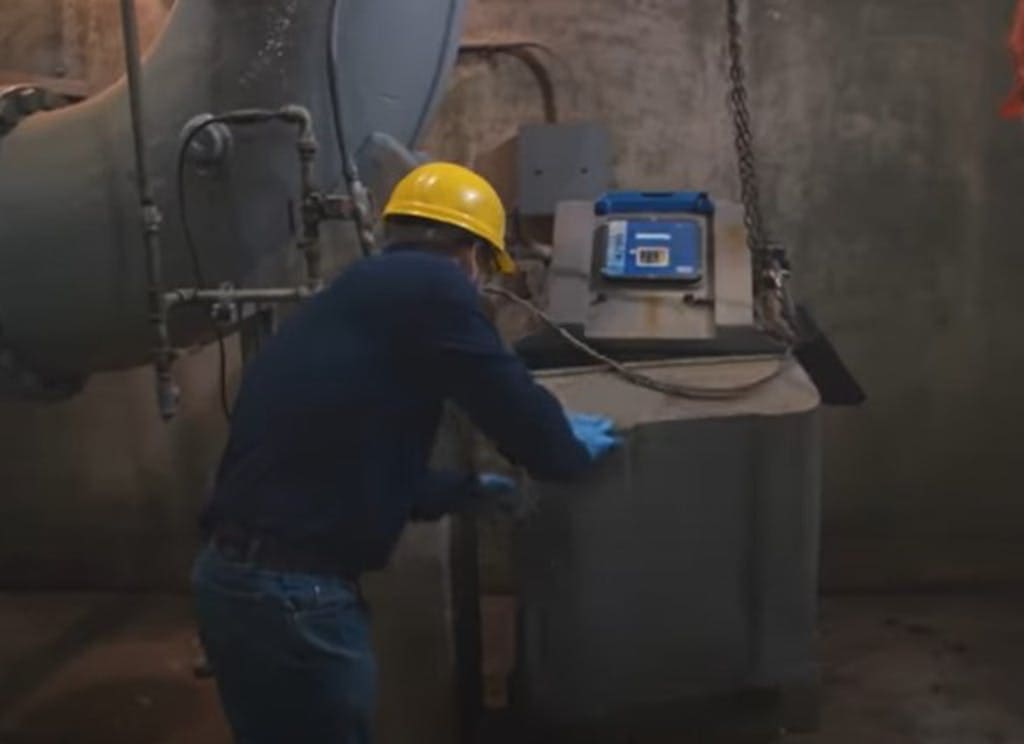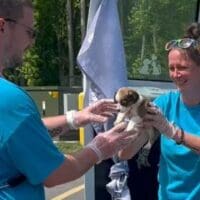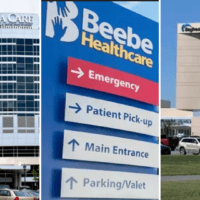
A New Castle County worker grabs sewage samples from the Middletown-Odessa-Townsend treatment plant.
When New Castle County considered where to locate pop-up COVID-19 testing sites for the week of March 15, one of the details it paid attention to was how much virus it was finding in sewage.
The amount of virus detected there usually rises or falls before that trend is seen in Delaware Division of Public Health statistics, said Michael D. Harris, manager of the county’s stormwater and environmental programs.
And it’s knowledge the county can act on. If virus numbers are much higher in one area, the county can set up testing there to try to catch cases early before they cause more infections, he said.
It’s the same way that the Houston Department of Health knew this week to warn residents and the medical community there that a lot of the U.K. variant of COVID-19 was in the wastewater. The numbers in Texas indicated “an ongoing and uncontrolled community spread” of that more infectious strain of the coronavirus.
U.S. health officials worry that new strains of the virus could cause another surge in positive cases, hospitalizations and deaths. It’s one reason for the massive push for vaccinations to go as fast as possible.
Error, group does not exist! Check your syntax! (ID: 11)
Testing for the presence of the virus in sewage is a technique that scientists are still trying to understand so they can use it to make more accurate predictions, said Kalmia Kneil, a University of Delaware professor of microbial food safety and director of the Center for Environmental and Wastewater-based Epidemiological Research (CEWER). Her program works with the county to evaluate their samples.
The county posts their work on a public dashboard and shows in a graphic how the viral count in wastewater closely resembles what’s happening with cases of COVID-19. There’s an international version, aptly designated the COVID19 Poops Dashboard.
“This is a growing technology,” Kneil said. “I was at a conference this morning with my colleagues in the UK, and the European Commission has really embraced wastewater testing and they are definitely using it in their policy development. In the US, we are a little bit slower to adopt it to make policy changes, but it’s a wonderful tool to use in collaboration with clinical testing.”
Dr. Rick Hong, medical director of the Delaware Division of Public Health, said that knowing how much COVID-19 is in sewage may help monitor outbreaks, but there are lots of questions about what the information means and how best to act on it.
“CEWER is still in the early stages of research work to determine if a more practical and useful approach can be developed,” Hong said in an emailed statement.
Error, group does not exist! Check your syntax! (ID: 11)
The state hasn’t partnered with the program because of the more immediate concerns of dealing with the pandemic, he said.
“It is still not yet clear how the data would be used should a virus be identified in the wastewater stream coming from a community,” he said.
Some of the question about it include how a community with high wastewater numbers should be monitored, whether the state has a mandate to require testing in that community and how the information should be reported to the community.
“We are finding that simply knowing that a virus is found in wastewater may or may not necessarily mean that there will be an outbreak,” Hong said. “We are currently trying to define more effective protocols that can provide actionable information.”
The virus gets into sewage when people urinate or poop. It can show up as soon as three days after being infected, and well before a person shows any symptoms, Harris and Kniel said.
After a year of working with the concept, scientists now know that people shed different amounts of the virus that way, making it hard to look at the total amount of virus and speculate how many people are sick. They also believe people may shed more virus at the start of an infection than toward the end, Harris said.
Error, group does not exist! Check your syntax! (ID: 11)
The county’s system can pull samples from the flow into a sewage processing plant, where it could be getting getting material from 450,000 people in New Castle County or just check what’s going in to a treatment plant for community, such as Newark or Delaware City or the Greenville-Pike Creek-Hockessin area.
The process that CEWER uses also has been used to check sewage for alcohol and narcotic drugs. Harris said public health officials in North Carolina tracked opiod use to decide where to offer help and intervention, and Italian officials have tracked tobacco use.
Kniel was using it to check for viruses and other pathogens in irrigation water so farmers can better utilize water sources and not rely on on groundwater. The UD team was asked to help the county and said yes.
Harris says collaborating with the university also cut their expenses from $1,000 for a test to $200.
“Pretty much, academic studies can do things less expensively than private industry,” Kniel said.


The county’s composite wastewater sampler collects sewage every 24 hours.
The county collects specimens using composite wastewater samplers, which are computer operated pumps. They put a hose into the waste stream and takes a sample every 24 hours, combining them all into a bottle. UD tests the overall system twice a week and the smaller sites once a week, usually retuning the readings in three days.
The county and UD have worked to optimize methods, Kniel said.
“Right now, we are analyzing the data and trying to make the most sense of how to correlate clinical cases with increases and decreases that we see in the wastewater surveillance program,” she said.
CEWER has just started looking for the COVID-19 variants that other places like Houston are seeing huge amounts of.
To do that, Kniel is working with UD’s bioinformatics and gene sequencing groups. Because it takes time to separate the virus DNA from all that floating around, it will take longer to turn that information around, she said.
Error, group does not exist! Check your syntax! (ID: 11)
Kniel said that the technology and science could be an increasingly important tool if the virus continues to change or re-emerge like influenza does.
“Better than than testing hundreds of people within a community, we can analyze the wastewater and find out what’s going on in that community in terms of potential for disease transmission,” she said.
Her team is interested in the work because of their passion for looking at the links between environmental health and public health, she said.
Kniel hopes the country will be able to avoid any rise in hospitalizations or death because of people are being vaccinated and because people continue to wear masks and social distance from others.
Ultimately, she pointed out, what New Castle County and CEWER are doing is trend analysis.
“So it’s really important that people don’t know get overly anxious about one change or one dot, so to speak, on those charts,” Kniel said. “We’re not able to get down to that very granular bit of data and that’s because the science is just unknown, and it’s been unfolding over the past year with this specific virus.”
Harris said people describe the process as a Swiss cheese model because there are so many unknowns. A lot of people don’t get tested because they are asymptomatic, but they are still shedding virus, even if they’re never tested and don’t show up on the state case list.
“You combine this information with clinical testing and all the other metrics, then I think it becomes useful,” he said. “It’s a piece of the puzzle to give you a complete picture of what’s happening.”


Betsy Price is a Wilmington freelance writer who has 40 years of experience.
Share this Post








